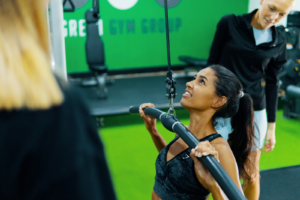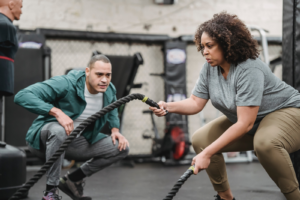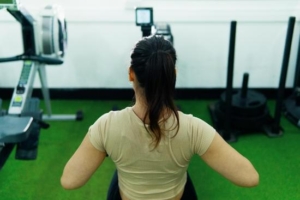Benefits of Using a Personal Trainer
Tired of going to the gym and not seeing the results you want? Need a little help with some motivation? We can help. Our personal trainers have years of experience in helping our clients achieve their fitness goals, below we explain how they can get you where you want to be.
One of the main benefits of working with a personal trainer is that they can provide guidance and support throughout the journey to achieving desired results. PTs can also tailor workouts to your specific needs, whether it be weight loss, muscle building, increased endurance or even rehabilitation.
PTs can offer motivation and accountability to those who may struggle with consistency in their fitness routine, sometimes all we need is someone cheering us on and reminding us of our progress to keep going! They can also teach proper form and technique during exercises, which helps prevent injury and ensures maximum effectiveness. Additionally, your trainer will stay up-to-date on the latest trends in health and fitness so they can incorporate new techniques into your workouts for optimal results.
Investing in a personal trainer is worthwhile for anyone looking to improve their overall health and fitness level. With professional guidance from an expert in the field, achieving your goals becomes easier than ever before.
Accountability and Customisation
One of the main advantages of working with a personal trainer is accountability. You’ll have someone who will keep you accountable for your fitness goals, create a personalised plan that suits your needs and lifestyle, and help you stick to it. They will motivate and encourage you to push beyond your limits, making sure that you are on track towards achieving your targets.
Another significant advantage of having a PT is customisation. Everyone’s body is unique, and what works for one person may not work for another. A personal trainer can tailor workouts specifically to meet your individual needs and preferences. Whether it’s weight loss, muscle gain or just general fitness, they can customise exercises based on any pre-existing medical conditions or injuries that may be present.
Education on Nutrition
Your PT can provide you with information on healthy eating habits, portion control, and how to properly fuel your bodies to get the most out of your workouts. They can also help you identify any nutritional deficiencies and recommend supplements or dietary changes.
With proper education in what you eat, you can improve your overall health and fitness levels. You’ll have a better understanding of what foods you should be consuming to reach your goals and how much you need to eat in order to maintain or lose weight or add muscle. Additionally, having a trained professional guide you through this process can provide accountability and support as you make lifestyle changes.
Incorporating nutrition education into personal training sessions can lead to long-term success by helping you make lasting changes in your diet and lifestyle habits. We have created a recipe library, meal plans, and a video-led nutritional education program on our website to get you started, but a PT can help create a personalised menu for your specific needs.
Life Long Benefits
When it comes to working out, hiring a personal trainer can seem like a costly extra to your workout budget. However, it’s important to do a cost comparison between hiring a personal trainer versus going at it alone, and consider the short and long-term benefits. A personal trainer can help you create a personalised workout plan that will maximise your time and effort in the gym, ultimately leading to faster and more effective results. Additionally, having someone hold you accountable for showing up to each session can help keep you on track.
The benefits of having a personal trainer extend far beyond just the immediate results you see in your fitness journey. One major benefit is injury prevention. A certified personal trainer will be able to identify any muscle imbalances or weaknesses and design workouts that address those issues, reducing the risk of injury during exercise or everyday activities. We have created a movement library that can help reduce the chances of doing exercises incorrectly but a PT can show you how and where you are going wrong.
Finally, having a personal trainer can help establish lifelong healthy habits. By teaching proper form and technique, providing guidance on nutrition, and encouraging consistency in your workouts, a PT can equip you with the tools needed to maintain an active lifestyle for years to come.
On the other hand, going without a personal trainer may result in wasted gym time and even potential injury from incorrect form or technique. Plus, without professional guidance, it can be difficult to know what exe
rcises are most beneficial for your specific body type and fitness goals. Ultimately, while there is certainly an investment involved with hiring a personal trainer, it’s one that could pay off when it comes to reaching your health and fitness objectives.
Invest in Yourself
Investing in yourself is one of the most important decisions you can make. This not only includes your education and career but also your physical and mental health. A personal trainer can offer numerous benefits to improve both aspects of your life.
A personal trainer will design a workout plan tailored specifically to your body type and fitness goals. They will ensure that you are performing exercises correctly to prevent injuries and maximise results. A PT will provide motivation and accountability which can be vital for those struggling to commit to a regular exercise routine on their own.
Working with a personal trainer can have significant impacts on mental health as well. Exercise has been shown to reduce stress levels, anxiety, depression symptoms, and increase overall mood. With all these benefits in mind, investing in a personal trainer could potentially be one of the best investments you make for yourself both physically and mentally.
If you think that having a personal trainer can benefit you, get in touch and we can connect you with one of our trainers to get you on the road to great physical and mental health.




